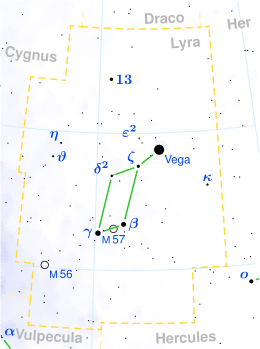V473 Lyrae
V473 Lyrae is a variable star in the constellation Lyra. It is an unusual Classical Cepheid variable with a visual range of 5.99 to 6.35.
 | |
| Observation data Epoch J2000 Equinox J2000 | |
|---|---|
| Constellation | Lyra |
| Right ascension | 19h 15m 59.48949s[1] |
| Declination | +27° 55′ 34.6870″[1] |
| Apparent magnitude (V) | 5.99 - 6.35[2] |
| Characteristics | |
| Spectral type | F7 II[3] |
| U−B color index | +0.272 - +0.392 |
| B−V color index | +0.554 - +0.750[4] |
| Variable type | δ Cep[2] |
| Astrometry | |
| Proper motion (μ) | RA: 4.31 ± 0.22[1] mas/yr Dec.: 0.63 ± 0.34[1] mas/yr |
| Parallax (π) | 2.33 ± 0.32[1] mas |
| Distance | 553[5] pc |
| Absolute magnitude (MV) | −2.5[6] |
| Details | |
| Mass | 3.0 - 4.6[6] M☉ |
| Radius | 24[6] R☉ |
| Luminosity | 740[6] L☉ |
| Surface gravity (log g) | 2.14[7] cgs |
| Temperature | 6,190[7] K |
| Metallicity [Fe/H] | −0.13[7] dex |
| Other designations | |
| Database references | |
| SIMBAD | data |
Discovery
V473 Lyrae is a faint naked eye star, but its brightness variations were not reported until 1968. It was noted to be possibly variable,[8] then examined as a possible δ Sct variable. It was confirmed as variable but the variations were considered semi-regular and so it was not catalogued as a δ Sct variable.[9]
In 1979, brightness variations were again noticed and V473 was listed as a short-period Cepheid, although the period was thought to be 3.04 days. The correct period was found a few years later at 1.49078 days, at the time the shortest known period for a galactic Cepheid. Unusual periodic variations in the pulsation amplitude were also noticed, similar to the Blazhko effect in RR Lyrae variables.[10]
Pulsations
The unusually short period of V473 Lyr is caused by pulsations in the second overtone and the fundamental pulsation period would be three times as long.[6] The amplitude variations have an approximate period of 1,205 days, and there is a secondary modulation with a period of 5,300 days.[10]
Companion
V473 Lyrae has a faint companion. Although the two stars are separated by 15", the companion is 15th magnitude and so faint that it is difficult to detect next to the naked eye primary. At the distance of V473 Lyrae, the separation corresponds to 8,300 astronomical units.[5]
X-rays
X-rays have been detected from V473 Lyrae during a survey looking for x-rays from young main sequence companions to Cepheid variables. However, the x-rays in this case appear to originate from the Cepheid itself, not from the companion. There may be a closer unseen companion or the x-rays may have another cause.[11]
References
- van Leeuwen, F. (November 2007), "Validation of the new Hipparcos reduction", Astronomy and Astrophysics, 474 (2): 653–664, arXiv:0708.1752, Bibcode:2007A&A...474..653V, doi:10.1051/0004-6361:20078357
- Samus, N. N.; Durlevich, O. V.; et al. (2009). "VizieR Online Data Catalog: General Catalogue of Variable Stars (Samus+ 2007-2013)". VizieR On-line Data Catalog: B/GCVS. Originally Published in: 2009yCat....102025S. 1. Bibcode:2009yCat....102025S.
- Gray, R. O.; Napier, M. G.; Winkler, L. I. (2001). "The Physical Basis of Luminosity Classification in the Late A-, F-, and Early G-Type Stars. I. Precise Spectral Types for 372 Stars". The Astronomical Journal. 121 (4): 2148. Bibcode:2001AJ....121.2148G. doi:10.1086/319956.
- Berdnikov, L. N. (2008). "VizieR Online Data Catalog: Photoelectric observations of Cepheids in UBV(RI)c (Berdnikov, 2008)". VizieR On-line Data Catalog: II/285. Originally Published in: 2008yCat.2285....0B. 2285. Bibcode:2008yCat.2285....0B.
- Evans, Nancy Remage; Bond, Howard E.; Schaefer, Gail H.; Mason, Brian D.; Tingle, Evan; Karovska, Margarita; Pillitteri, Ignazio (2016). "Hubble Space Telescope Snapshot Survey for Resolved Companions of Galactic Cepheids". The Astronomical Journal. 151 (5): 129. arXiv:1603.02224. Bibcode:2016AJ....151..129E. doi:10.3847/0004-6256/151/5/129.
- Andrievsky, S. M.; Kovtyukh, V. V.; Bersier, D.; Luck, R. E.; Gopka, V. P.; Yushchenko, A. V.; Usenko, I. A. (1998). "The unique galactic Cepheid V473 Lyrae revisited". Astronomy and Astrophysics. 329: 599. Bibcode:1998A&A...329..599A.
- Gray, R. O.; Graham, P. W.; Hoyt, S. R. (2001). "The Physical Basis of Luminosity Classification in the Late A-, F-, and Early G-Type Stars. II. Basic Parameters of Program Stars and the Role of Microturbulence". The Astronomical Journal. 121 (4): 2159. Bibcode:2001AJ....121.2159G. doi:10.1086/319957.
- Breger, M. (1968). "UBV and narrow-band UVBY photometry of bright stars". Astronomical Journal. 73: 84. Bibcode:1968AJ.....73...84B. doi:10.1086/110602.
- Breger, Michel (1969). "Short-Period Variability of b, a, and F Stars. III. A Survey of Delta Scuti Variable Stars". Astrophysical Journal Supplement. 19: 79. Bibcode:1969ApJS...19...79B. doi:10.1086/190199.
- Molnar, L.; Szabados, L. (2014). "V473 Lyrae, a unique second-overtone Cepheid with two modulation cycles". Monthly Notices of the Royal Astronomical Society. 442 (4): 3222–3234. arXiv:1406.0494. Bibcode:2014MNRAS.442.3222M. doi:10.1093/mnras/stu1091.
- Evans, Nancy Remage; Pillitteri, Ignazio; Wolk, Scott; Karovska, Margarita; Tingle, Evan; Guinan, Edward; Engle, Scott; Bond, Howard E.; Schaefer, Gail H.; Mason, Brian D. (2016). "Resolved Companions of Cepheids: Testing the Candidates with X-Ray Observations". The Astronomical Journal. 151 (4): 108. arXiv:1602.01797. Bibcode:2016AJ....151..108E. doi:10.3847/0004-6256/151/4/108.